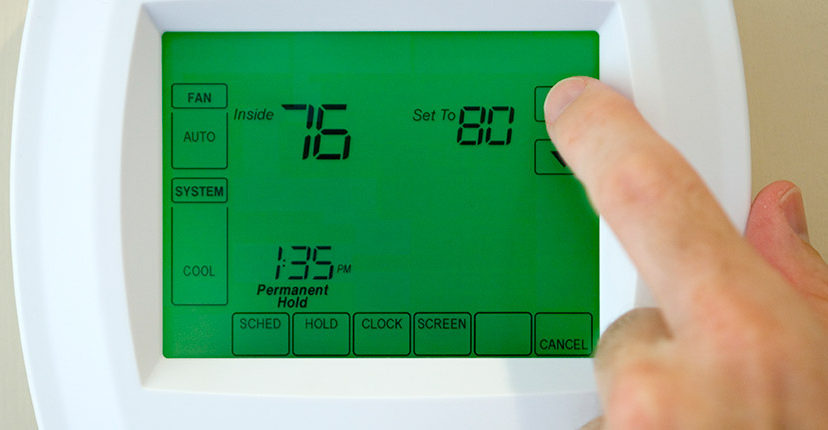
The heat of our Kansas summers may be something you’re looking forward to, but even if you’re dreading it, it’s not easily avoidable. A ceiling fan addition can be a stylish, yet comfortable way to prevent stagnant air and help increase energy efficiency. So, if you’re asking yourself if you should purchase that ceiling fan you saw while perusing your local home improvement store, here’s why the advantages outweigh the disadvantages.
Ceiling Fans Help With Air Circulation
A ceiling fan creates a current of air in a still room. The act of moving air around keeps it from getting stale and allows you to feel like you’re breathing fresh air. However, it’s important that you purchase the correct size ceiling fan for the most comfortable air circulation levels.
Ceiling Fans Keep You Cool
Ceiling fans keep the air in a room flowing. While the air isn’t actually any cooler than the room’s temperature, it acts as a breeze and feels cooler. To maximize the effects of a ceiling fan, you can leave the windows cracked open at night to let in the cool air.
Ceiling Fans Can Help With Energy Efficiency
Running an air conditioner all day can be expensive and create an uncomfortable feeling that’s almost too cold. Fans help to avoid this feeling by creating a cool breeze without chilling the air.
Ceiling Fans Provide a Classic Look
Ceiling fans were around long before air conditioning units, so they are a classic addition to any home. They can be installed indoors or outdoors to create a special setting. Today, ceiling fans are available in many different styles, materials and finishes, so you can find the perfect accessory for your personal style.
Ceiling Fans Add Light
Certain ceiling fans are equipped with lights while others can be retrofitted using light kits. The lights are almost always centered between the blades to avoid the strobe effect of spinning lights. Most ceiling fans with lights allow you to use just the light, just the fan or both together; the possibilities are endless which means you can create the perfect combination of light and air to suit your needs.
What Size Ceiling Fan Do I Need?
Choosing the right size ceiling fan ensures maximum performance, style and comfort levels. A small ceiling fan in a large room will have to work twice as hard, which will result in the motor burning out quickly. A large ceiling fan in a small room will create too much airflow. To avoid replacing your ceiling fan often, you’ll want to be sure that it’s proportionate to the room size.
- Determine which size fan you need. To do this, you’ll need to determine the square footage of the room it’s being installed in. Multiply the length plus the width of the room in order to get square feet. For a room that’s less than 75 square feet, a ceiling fan of 29-36 inches is recommended. A room that’s 76-144 square feet needs a ceiling fan of around 36-44 inches. For a room that measures 144-225 square feet, a ceiling fan of 44-54 inches is ideal. There should always be an 18 inch minimum distance from the blade to the wall.
- Determine how high to hang the fan. You want to make sure the ceiling fan is hanging at a high enough level to prevent people from hitting their heads, but also low enough to fit the look of the room. For a room with a ceiling height of eight feet, purchase a low profile ceiling fan. For a room with a ceiling height of nine feet and higher, purchase a ceiling fan downrod.
- Determine what size downrod you need. For a nine foot room, purchase a three inch or six inch downrod. For a ten foot room, purchase a 12 inch downrod. For a 12 foot room, purchase a 24 inch downrod. For a 36 foot room, purchase a 13 inch downrod.
Ceiling Fan Direction For Summer and Winter
Ceiling fans are a must-have for summer, but did you know that they’re also beneficial in cooler weather? Changing the direction of your ceiling fan depending on the season not only makes you feel comfortable, but it also allows you to adjust the thermostat and give your heating or air conditioning unit a break.
In the summer, your fan should be rotating counterclockwise in order to push cool air to the floor. The cool air evaporates perspiration and creates a wind chill effect, which makes you feel cooler without affecting the room temperature.
In the winter, ceiling fans should rotate clockwise at a low speed to pull cool air up. The gentle updraft pushes warm air, which naturally rises to the ceiling, back to the floor. This makes a room feel warmer, which allows you to decrease the use of your heater.
Ceiling Fan Cost and Installation
Ceiling fans are a small investment considering all of the benefits. No matter what your style, whether classic, modern or bold, there’s a ceiling fan to match. Depending on the type you choose and its size, prices can vary drastically. A basic ceiling fan from your local home improvement store could cost anywhere from $100 to $300 dollars, making cost the only real disadvantage.
Ceiling fan installation can be done by an experienced homeowner or by a licensed electrician. This is largely dependant on whether wiring needs to be run to the fan, and if there is already a lightswitch to operate the fan. When in doubt, contact Graf Electric for proper installation and wiring.
By adding a ceiling fan, you get many benefits packed into a small purchase. No matter what the season, you can decrease your energy consumption and maximize your comfort levels, all with the touch of a switch.

